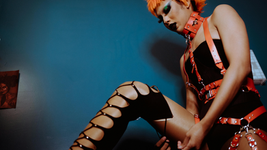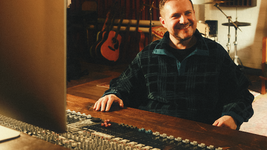Artistry and Selfhood at Edinburgh Fringe Festival
- Noelle C. Sacher
- Oct 9, 2023
- 5 min read
Writer Noelle Sacher considers the ways different artists cohabit the same networks, and how this impacts both their artistry and personhood.
There is a tradition on the last night of every Edinburgh Fringe Festival in which anyone brave, stupid, or drunk enough will hike up Arthur’s Seat to watch the sunrise together. My boyfriend, a comedian who had been performing at the festival for the whole month, and I followed his friends out of their usual bar and into the wild. We trekked up carefully, only stepping on the stones deemed safe by the performers before us. When we arrived at the top, the comedians joined together as the famous clown Viggo Venn popped a bottle of champagne. I looked to my right and watched as the actors stretched out, exhausted, across the rocks. I looked ahead and recognized cabaret performers and drag queens out of drag, staring into the sun. And I stood in the centre, surrounded by artists who didn’t seem to care that they were surrounding each other.

I arrived in Edinburgh at the beginning of the final week of Fringe. The Edinburgh Fringe Festival advertises itself as a festival of all arts, but it easily can be organized into three main categories of performance: theatre, comedy, and drag/cabaret. I found myself at the intersection of these three subcategories as a queer actress dating a comedian, so before my trip I browsed Fringe’s printed magazine, excitedly circling shows like a child circling their Christmas wishlist in a toy catalogue.
Many friends of mine had been there for the whole month, some doing stand-up shows and sketch comedies, others in dramatic theatre pieces. After doing shows every day for 21 days, these friends realized in their last week that they had not seen as much as they had wanted to. I suddenly had a date to every production I’d decided to attend. This was expected, and part of why I decided to attend Fringe’s final days. What I didn’t expect, however, was the lack of diversity of shows my artist friends had seen. Every actor I spoke to said they hadn’t seen enough comedy while every comedian I spoke to said they hadn’t seen enough theatre. These subsections of artists rarely interacted.
"Exclusively seeing performances similar to your own is narcissism disguised as research."
This segregation of mediums stretched into the social life of EDFringe. My boyfriend took me to bars he’d been frequenting during his month: The Abbatoir, the Assembly Members’ Bar, Brook’s Bar. In each of these places, comedians flooded the venue, networking and chatting about each other’s shows. Meanwhile, every time we went out at a theatre Fringe venue, like Summerhall or Underbelly at Cowgate, we ran into friends of mine. Actors, producers, and directors networking and chatting about each other’s shows. The cabaret artists often huddled for drinks at a venue under a bridge. A small caravan-turned-bar with tarot readings and folks in drag sat on picnic benches outside, networking and chatting about each other’s shows. Sometimes I went to the public tourist pubs just to get away from the business of it all.
But as a professional artist, I had to think about the business of it all. Why would a comedian only network with someone doing the same job, rather than with stage directors and producers? Why would an actor only network with fellow stage artists, rather than with a comedian writing sketches and short films? And why did it feel like all of the queer, variety, drag acts were a diaspora made to live in the shadows of the other art forms?
I have concluded two main reasons for this evident divide at Fringe:
1. Artists will see art that reminds them of their own as a way of comparing their work to others’.
2. People are more comfortable spending their free-time with like-minded people.
I have also concluded two main problems with the reasons above:
1. Art is at its best when it cannot be defined as one thing:
A piece that adheres to strictly one genre, like a dramatic theatre production with no laughter or a stand-up comedy hour with no heart, becomes tedious to watch. To have three-dimensional art, your production must be informed with interdisciplinary works. This is not to say that a gut-wrenching Shakespeare piece needs to be punched up with a sitcom writers’ room, but that to find what makes a gut-wrenching Shakespeare piece speak to an audience requires the artist to look outside of Shakespeare. The best comedy is vulnerable at its core, and who is more vulnerable than an actor who has been trained to portray deep emotions at the drop of a hat?
I'll provide an example of the benefit of interdisciplinary art influence outside of the Edinburgh Fringe confines: many film directors will curate shots that are inspired by visual arts, like how Robert Eggers utilized paintings by Sascha Schneider and Jean Delville in The Lighthouse (2019). Exclusively seeing Fringe performances that are similar to your own is narcissism disguised as research. Seeing art that is entirely different will help inform and shape your work; you open your own art up to new possibilities.
2. An open-minded approach is essential for one's self and art:
In the same way I argue that having a limited repertoire of art consumed creates one-dimensional and boring products, I believe that having a limited repertoire of artists in your life creates a one-dimensional and boring person. Artist or not, in regard to your work or not, sticking around only like-minded people with exclusively common interests creates a closed-minded life. To discover one’s own sense of self, taste, hobbies, and passions, one has to test out all sorts of things. Seeing, reading, watching, and otherwise consuming art from different backgrounds on opposing subjects builds a personal encyclopaedia of references, a diversity of friendship, and a critical eye. By surrounding yourself with people pursuing various mediums who have opinions and preferences independent of yours, you learn more about yourself and the world around you. This will always then bleed into your own artistic work as well.

There was one man I met at The Abbatoir, a comedian and actor. He had previously done Edinburgh Fringe performing in a play, but this year he was back with a one-man sketch show. On the penultimate evening of the festival, after being too drunk to get into one of our usual haunts, he took us to the spot under the bridge where the cabaret performers convened. Everyone hugged him hello. It felt like when you were a kid and saw a teacher outside of school, dissociative and bizarre. I had become so used to the social order of the Fringe, knowing in which places I’d run into which friends, and suddenly this man was breaking down those walls before me. He was an interesting guy, smart and curious and kind. I couldn’t help but think this related to his obvious openness artistically and socially.
When we stood atop Arthur’s Seat, drunk and tired and watching the orange sun rise over Edinburgh, I heard people saying how unifying this tradition felt. Yet all I could do was look around and see the gaps between the groups of artists, comedians and actors and performers separated by rocks. It’s easy to fall into a pattern, into the social and artistic confines of a long-running event. But even as exhausted as we were on our hike down, we veered left, away from the other artists, and found a new path back to town.
Edited by Georgia Gibson, Theatre Editor.


































Коментарі